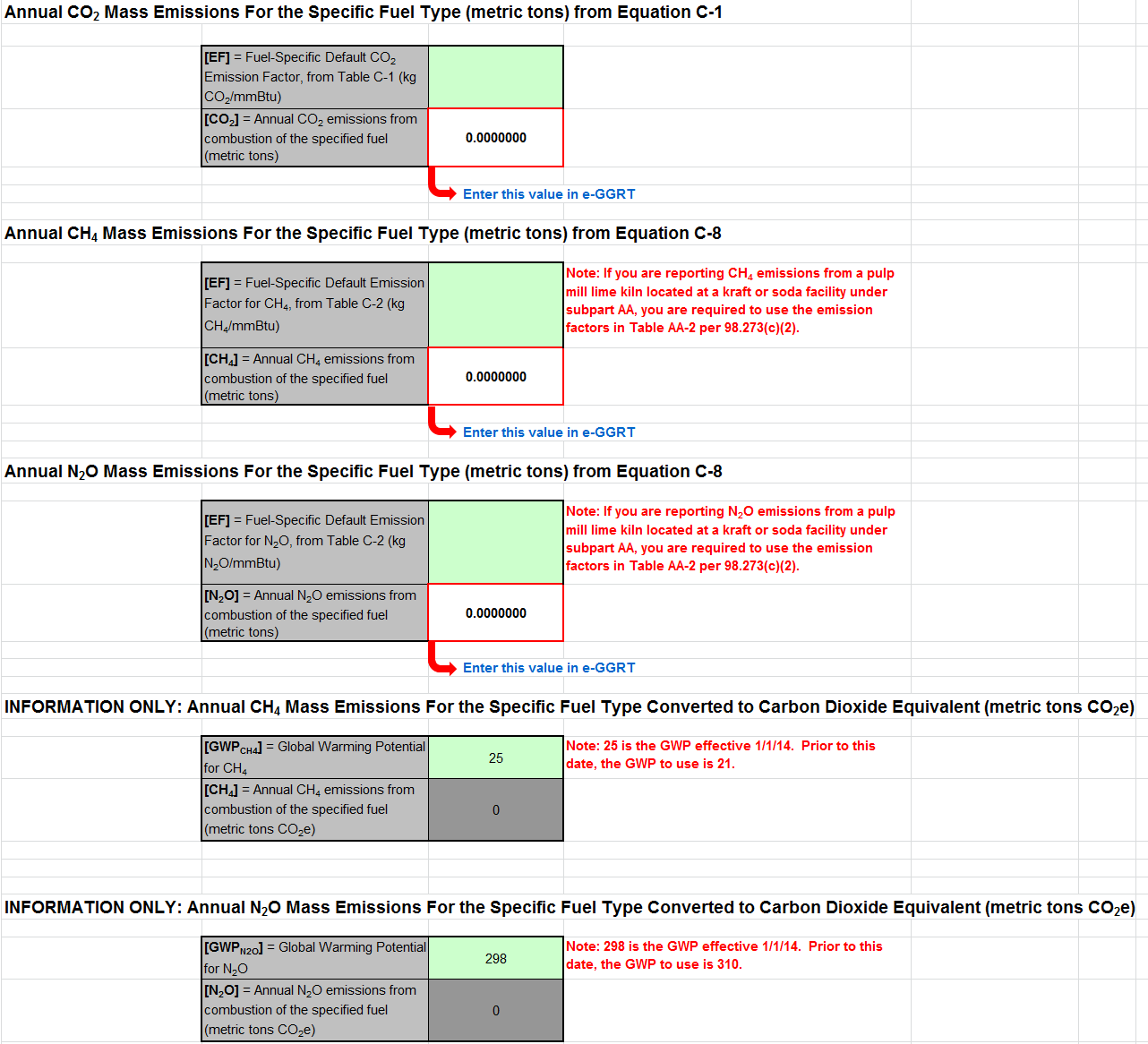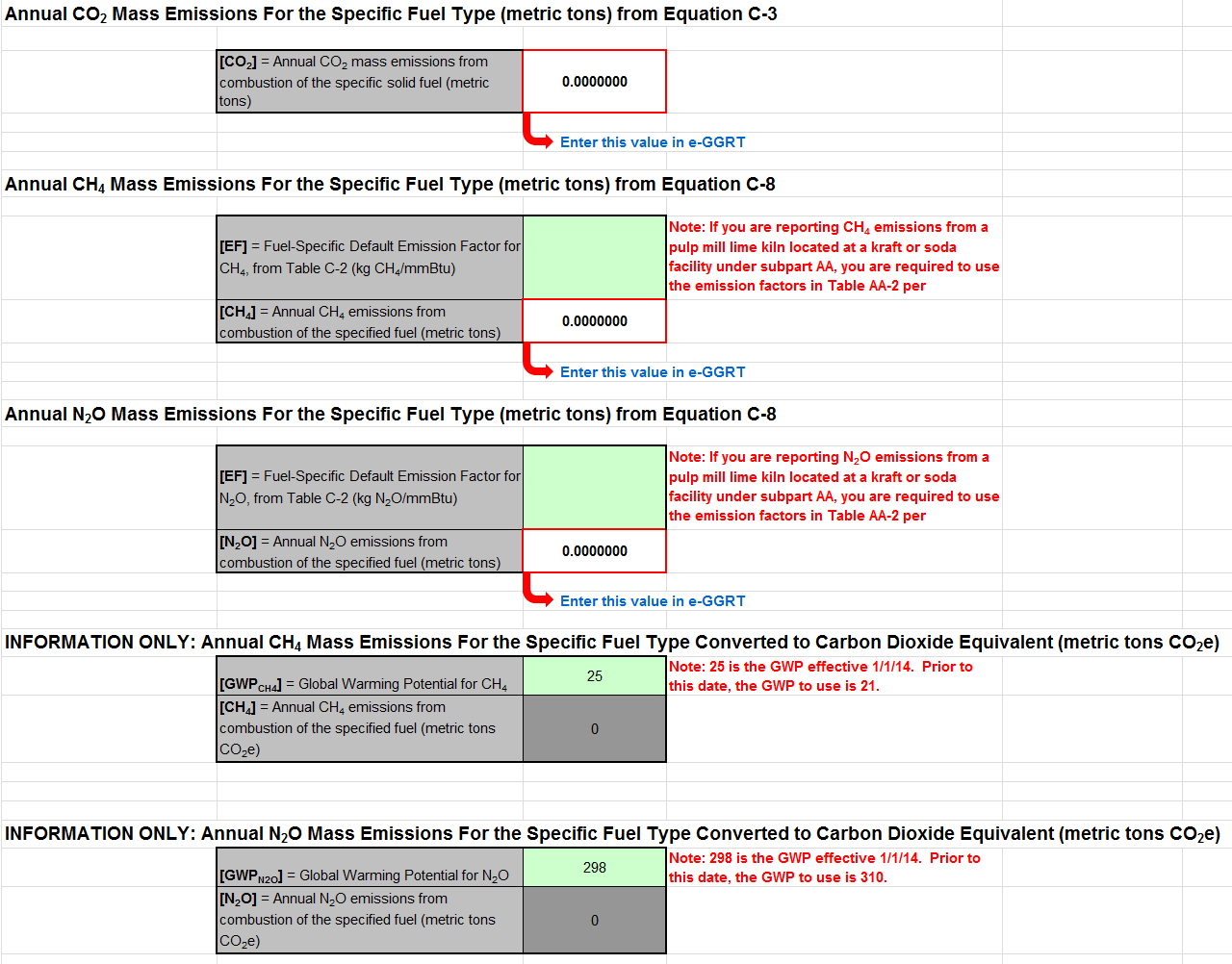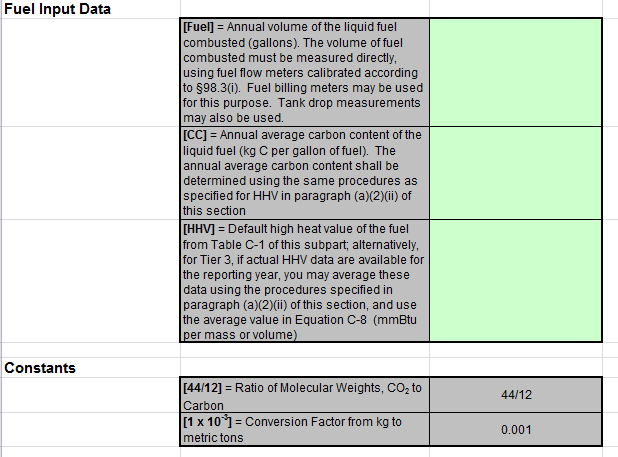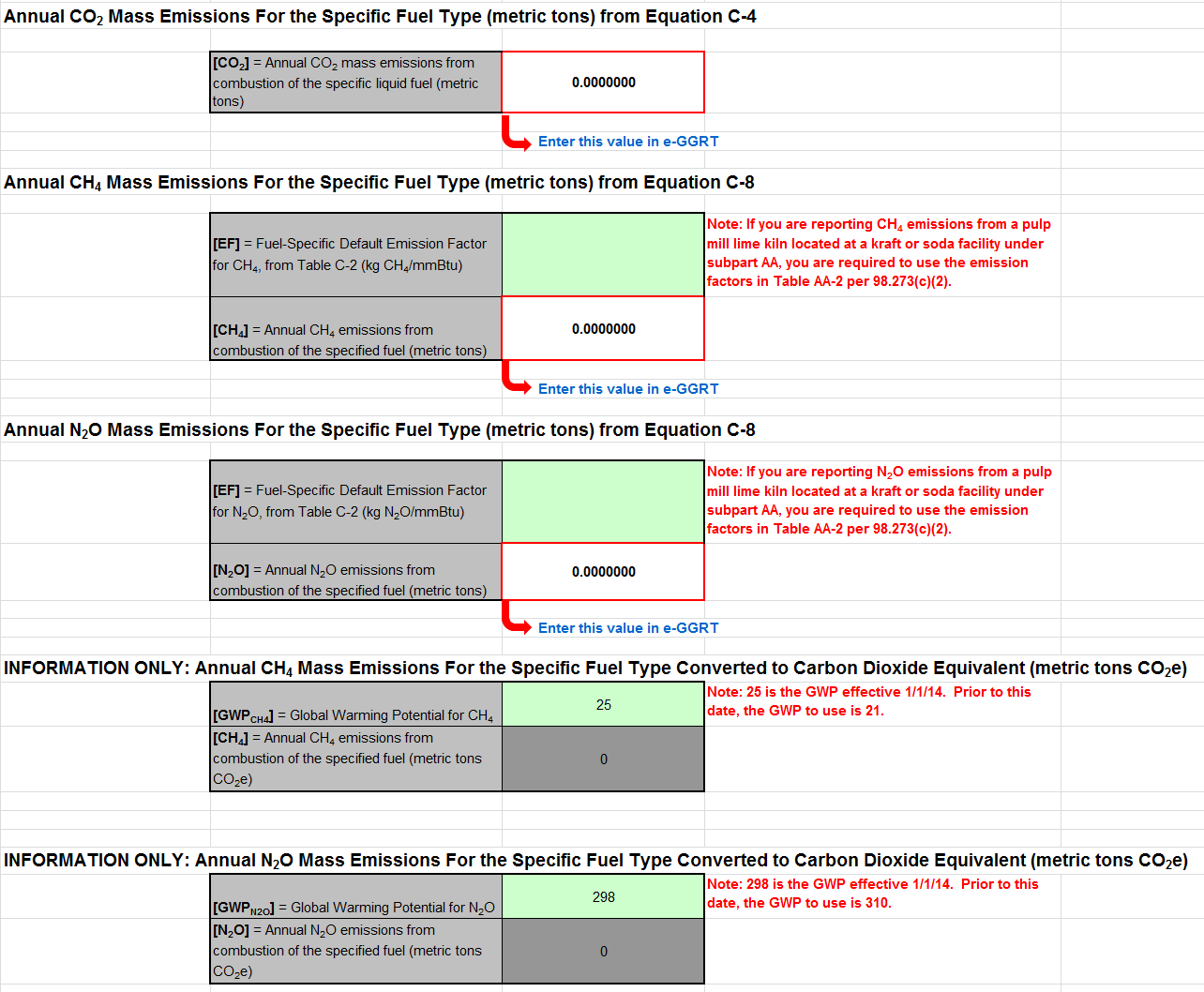These optional spreadsheets are provided to assist reporters in calculating emissions and in keeping records of these calculations.
Reporters are required to keep records of these calculations under 40 CFR 98.3(g) and additional subpart-specific provisions, but are not required to use these spreadsheets or to submit any spreadsheets to EPA.
Spreadsheets may include inputs to emission equations, reporting of some of which EPA deferred until 2015.
(See 76 FR 53057, published August 25, 2011, http://www.gpo.gov/fdsys/pkg/FR-2011-08-25/pdf/2011-21727.pdf).
The data elements deferred until 2013 that will be collected for the first time in RY2012 enable emissions calculations to be executed within e-GGRT for certain subpart equations. As a result, affected Optional Calculation Spreadsheets will become obsolete. The Optional Calculation Spreadsheets associated with the equations below will become obsolete for this subpart beginning RY2012:
- Equation C-11
Copies of these spreadsheets can be downloaded at the Calculation Spreadsheet Archive.
Overview
This help page provides guidance for working with the supplemental subpart C calculation spreadsheets. The guidance provides step-by-step instructions for the following tasks:
- Selecting the Appropriate Calculation Spreadsheet
- Downloading a Calculation Spreadsheet
- General Information on Using a Calculation Spreadsheet
- Using the Equation C-1, C-8 Calculation Spreadsheet
- Using the Equation C-1a, C-8a Calculation Spreadsheet
- Using the Equation C-1b, C-8b Calculation Spreadsheet
- Using the Equation C-2a, C-2b, C-9a Calculation Spreadsheet
- Using the Equation C-2c, C-9b Calculation Spreadsheet
- Using the Equation C-3, C-8 Calculation Spreadsheet
- Using the Equation C-4, C-8 Calculation Spreadsheet
- Using the Equation C-5, C-8 Calculation Spreadsheet
- Using the Equation C-10 Calculation Spreadsheet
Specific information on each of the calculation spreadsheets is provided below:
|
Calculation Spreadsheet |
Instructions |
|---|---|
| Equation C-10 Calculation Spreadsheet.xls | C10 Help |
Selecting the Appropriate Calculation Spreadsheet
To calculate emissions for stationary combustion units reporting under subpart C, users may use the spreadsheets described in the table below. The equations for calculating CO2 mass emissions and CH4/N2O mass emissions are combined onto one spreadsheet as appropriate. The table below describes the equation inputs, outputs, and the Tier and e-GGRT configuration types in which each equation may apply. Note that some Tiers and Configurations only allow the use of a given equation for certain situations. Ultimately, the user should refer to 40 CFR 98.33(b) to determine which Tier is allowed and to 40 CFR 98.33(a) to determine which equation within a Tier is appropriate. If a configuration combusts multiple fuel types, it is possible that different tiers and different equations may be used for that given configuration. The spreadsheets are designed to account for one type of fuel, so each additional fuel combusted in a configuration will need a new spreadsheet.
|
Calculation Spreadsheet |
Tier |
Basis for Calculations |
Configuration |
Output(s) |
|---|---|---|---|---|
|
1 |
EF, Fuel Use, Default HHV |
1, 3, 4 |
CO2 | |
|
1 |
EF, Natural Gas Billing Records |
1, 3, 4 |
CO2 | |
|
1 |
EF, Natural Gas Billing Records |
1, 3, 4 |
CO2 | |
|
2 |
EF, Fuel Use, Measured HHV |
1, 3, 4 |
CO2 | |
|
2 |
EF, Steam Use, Boiler Max Rated Heat Input Capacity |
1, 3, 4 |
CO2 | |
|
3 |
Fuel Use, Measured Fuel Carbon Content |
1, 3, 4 |
CO2 | |
|
3 |
Fuel Use, Measured Fuel Carbon Content |
1, 3, 4 |
CO2 | |
|
3 |
Fuel Use, Measured Fuel Carbon Content |
1, 3, 4 |
CO2 | |
| Equation C-10 Calculation Spreadsheet.xls | 4 | EF, Heat Input from Combustion | 2, 5, 6 | CH4 N2O |
Tier 1 Calculation Methodology
To calculate annual CO2, CH4, and N2O mass emissions for each type of fuel using Tier 1 in each reporting configuration, use Equation C-1, C-8 Calculation Spreadsheet, Equation C-1a, C-8a Calculation Spreadsheet (natural gas billed in therms only), or Equation C-1b, C-8b Calculation Spreadsheet (natural gas billed in mmBtu only).
Equation C-1, C-8 Calculation Spreadsheet
Use this spreadsheet to calculate the annual CO2, CH4, and N2O mass emissions for a stationary fuel combustion configuration that uses the Equation C-1, Tier 1 calculation methodology for any given fuel. Use Equation C-1 on this spreadsheet except when natural gas billing records are used to quantify fuel usage and gas consumption is expressed in units of therms or million Btu. In that case, use Equation C-1a or C-1b, as applicable. This spreadsheet performs the calculation using Equations C-1 and C-8, which are provided below:
(Equation C-1)
(Equation C-8)
Equation C-1a, C-8a Calculation Spreadsheet
Use this spreadsheet to calculate the annual CO2, CH4, and N2O emissions from natural gas usage for a configuration that fires natural gas and only if billing records are used to quantify fuel usage and gas consumption is expressed in units of therms. This spreadsheet performs the calculations using Equations C-1a and C-8a, which are provided below:
(Equation C-1a)
(Equation C-8a)
Equations C-1b, C-8b Calculation Spreadsheet
Use the spreadsheet below to calculate the annual CO2, CH4, and N2O emissions from natural gas usage for a configuration that fires natural gas and only if billing records are used to quantify fuel usage and gas consumption is expressed in units of mmBtu. This spreadsheet performs the calculations using Equations C-1b and C-8b, which are provided below.
(Equation C-1b)
(Equation C-8b)
Tier 2 Calculation Methodology
To calculate annual CO2, CH4, and N2O mass emissions for each type of fuel in each reporting configuration, use Equation C-2a, C-2b, C-9a Calculation Spreadsheet or Equation C-2c, C-9b Calculation Spreadsheet.
Equation C-2a, C-2b, C-9a Calculation Spreadsheet
Use this spreadsheet to calculate the annual CO2, CH4, and N2O mass emissions for a stationary fuel combustion configuration that uses the Tier 2 calculation methodology. This spreadsheet performs the calculation using Equations C-2a, C-2b, and C-9a, which are provided below (although included, Equation C-2b is not always required, see 40 CFR 98.33(a)(2)(ii)):
(Equation C-2a)
(Equation C-2b)
(Equation C-9a)
Equation C-2c, C-9b Calculation Spreadsheet
Use this spreadsheet to calculate the annual CO2, CH4, and N2O emissions for a stationary fuel combustion configuration that uses the Equation C-2c, Tier 2 calculation methodology. This worksheet should be used for MSW when the use of Tier 2 is allowed or (optionally) for solid fuels using Tier 2 that generate steam. This spreadsheet performs the calculations using Equations C-2c and C-9b, which are provided below:
(Equation C-2c)
(Equation C-9b)
Tier 3 Calculation Methodology
To calculate the annual CO2, CH4, and N2O mass emissions for each type of fuel using Tier 3 in each type of reporting configuration, use Equation C-3, C-8 Calculation Spreadsheet, Equation C-4, C-8 Calculation Spreadsheet, or Equation C-5, C-8 Calculation Spreadsheet.
Equation C-3, C-8 Calculation Spreadsheet
Use the spreadsheet below to calculate the annual CO2, CH4, and N2O mass emissions for solid fuels using Tier 3 Calculation methodology at each configuration. This spreadsheet performs the calculation using Equations C-3 and C-8, which are provided below:
(Equation C-3)
(Equation C-8)
Equation C-4, C-8 Calculation Spreadsheet
Use the spreadsheet below to calculate the annual CO2, CH4, and N2O mass emissions for liquid fuels using the Tier 3 calculation methodology at each configuration. This spreadsheet performs the calculations using Equations C-4 and C-8, which are provided below:
(Equation C-4)
(Equation C-8)
Equations C--5, C-8 Calculation Spreadsheet
Use the spreadsheet below to calculate the annual CO2, CH4, and N2O mass emissions for gaseous fuels using the Tier 3 calculation methodology at each configuration. This spreadsheet performs the calculations using Equations C-5 and C-8, which are provided below:
(Equation C-5)
(Equation C-8)
Downloading a Calculation Spreadsheet
Calculation spreadsheets for subpart C may be downloaded by clicking one of the links in the first column of the table below. Users may also jump to instructions for each calculation spreadsheet by clicking one of the links in the second column.
|
Calculation Spreadsheet |
Instructions |
|---|---|
Using a Calculation Spreadsheet to Make Calculations
The guidance provided in this section applies to each of the calculation spreadsheets for subpart C. Additional guidance is provided for each individual calculation spreadsheet in the sections below.
Color coding
The calculation spreadsheets contain green input cells, gray informational cells, and red-bordered results cells filled with yellow or white. Users should use green input cells to enter all data specific to their facility, unit, or process. Gray informational cells contain parameter names, column and row headings, equation constants and subtotals. Calculation results are displayed in red-bordered results cells filled with yellow or white. For red-bordered, yellow-filled results cells, the values in these cells should be entered in the appropriate and separate calculation spreadsheet (as directed below cell) where additional calculations will be made. For red-bordered, white filled results cells, the values in these cells should be entered in e-GGRT for the appropriate process units. All cells that are not green input cells are locked and cannot be modified.
|
Green input cell (data entry) |
|
Gray informational cells (locked) |
|
Red-bordered, yellow-filled results cells (enter in appropriate and separate calculation spreadsheet) |
|
Red-bordered, white filled results cells (enter in e-GGRT) |
Stop and Warning Messages
The calculation spreadsheets will display a stop message if the user enters a value that is invalid or a warning message if the user enters a value outside the EPA estimated range for a particular data element. For invalid data entries, the stop messages will not allow a user to proceed and the user must reenter valid data before moving forward. For data entries that are outside the EPA estimated range for a particular data element, the warning messages will allow a user to proceed if the user deems the entered value to be accurate.
Multiple Configuration Types and Multiple Fuels
Users with multiple configuration types and multiple fuels should use separate calculation spreadsheets for each configuration type and for each fuel. Users should not aggregate data for multiple configuration types or fuels when using these calculation spreadsheets.
Using the Equation C-1, C-8 Calculation Spreadsheet
Use this spreadsheet to calculate the annual CO2, CH4, and N2O mass emissions for a stationary fuel combustion configuration that uses the Equation C-1, Tier 1 calculation methodology for any given fuel. Use Equation C-1 on this spreadsheet except when natural gas billing records are used to quantify fuel usage and gas consumption is expressed in units of therms or million Btu. In that case, use Equation C-1a or C-1b, as applicable. Use a separate spreadsheet for each configuration and for each fuel. The Equation C-1, C-8 Calculation Spreadsheet performs the calculations using Equations C-1 and C-8 provided below.
(Equation C-1)
(Equation C-8)
Begin by entering the facility name, your name, the configuration identifier, reporting period, and any additional comments in the green input cells of the general information table located immediately below the equation in the calculation spreadsheet. This is for your records.
Next, enter the requested information in the green input cells in the Fuel Input Data table.
The calculation spreadsheet will calculate the annual CO2, CH4, and N2O emissions from fuel combustion. The calculation spreadsheet will also convert CH4 and N2O emissions to units of carbon dioxide equivalent (CO2e). The calculated values will be displayed in red-bordered cells at the bottom of the spreadsheet. These values should be entered in e-GGRT for this fuel and configuration type combination.
Using the Equation C-1a, C-8a Calculation Spreadsheet
Use this spreadsheet to calculate the annual CO2, CH4, and N2O emissions from natural gas usage for a configuration that fires natural gas and if billing records are used to quantify fuel usage and gas consumption is expressed in units of therms. Use a separate spreadsheet for each configuration and for each fuel. The Equation C-1a, C-8a Calculation Spreadsheet performs the calculations using Equations C-1a and C-8a provided below.
(Equation C-1a)
(Equation C-8a)
Begin by entering the facility name, your name, the configuration identifier, reporting period, and any additional comments in the green input cells of the general information table located immediately below the equation in the calculation spreadsheet. This is for your records.
Next, enter the requested information in the green input cells in the Fuel Input Data table.
The calculation spreadsheet will calculate the annual CO2, CH4, and N2O emissions from fuel combustion. The calculation spreadsheet will also convert CH4 and N2O emissions to units of carbon dioxide equivalent (CO2e). The calculated values will be displayed in red-bordered cells at the bottom of the spreadsheet. These values should be entered in e-GGRT for this fuel and configuration type combination.
Using the Equation C-1b, C-8b Calculation Spreadsheet
Use this spreadsheet to calculate the annual CO2 , CH4, and N2O emissions from natural gas usage for a configuration that fires natural gas and if billing records are used to quantify fuel usage and gas consumption is expressed in units of mmBtu. Use a separate spreadsheet for each configuration and for each fuel. The Equation C-1b, C-8b Calculation Spreadsheet performs the calculations using Equations C-1b and C-8b provided below.
(Equation C-1b)
(Equation C-8b)
Begin by entering the facility name, your name, the configuration identifier, reporting period, and any additional comments in the green input cells of the general information table located immediately below the equation in the calculation spreadsheet. This is for your records.
Next, enter the requested information in the green input cells in the Fuel Input Data table.
The calculation spreadsheet will calculate the annual CO2, CH4, and N2O emissions from fuel combustion. The calculation spreadsheet will also convert CH4 and N2O emissions to units of carbon dioxide equivalent (CO2e). The calculated values will be displayed in red-bordered cells at the bottom of the spreadsheet. These values should be entered in e-GGRT for this fuel and configuration type combination.
Using the Equation C-2a, C-2b, C-9a Calculation Spreadsheet
Use this spreadsheet to calculate the annual CO2, CH4, and N2O mass emissions for a stationary fuel combustion configuration that uses the Equation C-2a, Tier 2 calculation methodology. This spreadsheet performs the calculation using Equations C-2a, C-2b, and C-9a, which are provided below (although included, Equation C-2b is not always required, see 40 CFR 98.33(a)(2)(ii)). Use a separate spreadsheet for each configuration and for each fuel. The Equation C-2a, C-2b, C-9a Calculation Spreadsheet performs the calculations using Equations C-2a, C-2b, and C-9a provided below.
(Equation C-2a)
(Equation C-2b)
(Equation C-9a)
Begin by entering the facility name, your name, the configuration identifier, reporting period, and any additional comments in the green input cells of the general information table located immediately below the equation in the calculation spreadsheet. This is for your records.
Next, enter the requested information in the green input cells in the Input for Weighted Annual Average HHV (only if required or elected) table.
The calculation spreadsheet will calculate the weighted annual average high heat value of the fuel (HHVannual). The calculated value will be displayed in a red-bordered cell with yellow fill above the Fuel Input Data table. This value should be entered in the Fuel Input Data table (shown below) along with the mass or volume of fuel combusted during the reporting year. Alternatively, you may enter an annual average HHV consistent with Section 98.33(a)(2)(ii).
Next, enter the requested information in the green input cells in the Fuel Input Data table.
The calculation spreadsheet will calculate the annual CO2, CH4, and N2O emissions from fuel combustion. The calculation spreadsheet will also convert CH4 and N2O emissions to units of carbon dioxide equivalent (CO2e). The calculated values will be displayed in red-bordered cells with white fill at the bottom of the spreadsheet. These values should be entered in e-GGRT for this fuel and configuration type combination.
Using the Equation C-2c, C-9b Calculation Spreadsheet
Use this spreadsheet to calculate the annual CO2, CH4, and N2O emissions for a stationary fuel combustion configuration that uses the Equation C-2c, Tier 2 calculation methodology. This spreadsheet should be used for MSW when the use of Tier 2 is allowed or (optionally) for solid fuels using Tier 2 in units that generate steam. Use a separate spreadsheet for each configuration and for each fuel. The Equation C-2c, C-9b Calculation Spreadsheet performs the calculations using Equations C-2c and C-9b provided below.
(Equation C-2c)
(Equation C-9b)
Begin by entering the facility name, your name, the configuration identifier, reporting period, and any additional comments in the green input cells of the general information table located immediately below the equation in the calculation spreadsheet. This is for your records.
Next, enter the requested information in the green input cells in the Fuel Input Data table.
The calculation spreadsheet will calculate the annual CO2, CH4, and N2O emissions from fuel combustion. The calculation spreadsheet will also convert CH4 and N2O emissions to units of carbon dioxide equivalent (CO2e). The calculated values will be displayed in red-bordered cells at the bottom of the spreadsheet. These values should be entered in e-GGRT for this fuel and configuration type combination.
Using the Equation C-3, C-8 Calculation Spreadsheet
Use this spreadsheet to calculate the annual CO2, CH4, and N2O mass emissions for solid fuels using Tier 3 Calculation methodology at each configuration. Use a separate spreadsheet for each configuration and for each fuel. The Equation C-3, C-8 Calculation Spreadsheet performs the calculations using Equations C-3 and C-8 provided below.
(Equation C-3)
(Equation C-8)
Begin by entering the facility name, your name, the configuration identifier, reporting period, and any additional comments in the green input cells of the general information table located immediately below the equation in the calculation spreadsheet. This is for your records.
Next, enter the requested information in the green input cells in the Fuel Input Data table.
The calculation spreadsheet will calculate the annual CO2, CH4, and N2O emissions from fuel combustion. The calculation spreadsheet will also convert CH4 and N2O emissions to units of carbon dioxide equivalent (CO2e). The calculated values will be displayed in red-bordered cells at the bottom of the spreadsheet. These values should be entered in e-GGRT for this fuel and configuration type combination.
Using the Equation C-4, C-8 Calculation Spreadsheet
Use this spreadsheet to calculate the annual CO2, CH4, and N2O mass emissions for liquid fuels using the Tier 3 calculation methodology at each configuration. Use a separate spreadsheet for each configuration and for each fuel. The Equation C-4, C-8 Calculation Spreadsheet performs the calculations using Equations C-4 and C-8 provided below.
(Equation C-4)
(Equation C-8)
Begin by entering the facility name, your name, the configuration identifier, reporting period, and any additional comments in the green input cells of the general information table located immediately below the equation in the calculation spreadsheet. This is for your records.
Next, enter the requested information in the green input cells in the Fuel Input Data table.
The calculation spreadsheet will calculate the annual CO2, CH4, and N2O emissions from fuel combustion. The calculation spreadsheet will also convert CH4 and N2O emissions to units of carbon dioxide equivalent (CO2e). The calculated values will be displayed in red-bordered cells at the bottom of the spreadsheet. These values should be entered in e-GGRT for this fuel and configuration type combination.
Using the Equation C-5, C-8 Calculation Spreadsheet
Use this spreadsheet to calculate the annual CO2, CH4, and N2O mass emissions for gaseous fuels using the Tier 3 calculation methodology at each configuration. Use a separate spreadsheet for each configuration and for each fuel. The Equation C-5, C-8 Calculation Spreadsheet performs the calculations using Equations C-5 and C-8 provided below.
(Equation C-5)
(Equation C-8)
Begin by entering the facility name, your name, the configuration identifier, reporting period, and any additional comments in the green input cells of the general information table located immediately below the equation in the calculation spreadsheet. This is for your records.
Next, enter the requested information in the green input cells in the Fuel Input Data table.
The calculation spreadsheet will calculate the annual CO2, CH4, and N2O emissions from fuel combustion. The calculation spreadsheet will also convert CH4 and N2O emissions to units of carbon dioxide equivalent (CO2e). The calculated values will be displayed in red-bordered cells at the bottom of the spreadsheet. These values should be entered in e-GGRT for this fuel and configuration type combination.
Using the Equation C-10 Calculation Spreadsheet
Use the Equation C-10 Calculation Spreadsheet to calculate annual CH4, and N2O emissions using an emission factor and the annual heat input from a fuel combusted in units that use Tier 4 (CEMS, Configuration Types 2 and 5), or, to check e-GGRT’s calculations of annual CH4, and N2O emissions for units that report under 40 CFR Part 75 (Configuration Type 6). You can also use the Equation C-10 Calculation Spreadsheet to calculate annual CH4 and N2O emissions from fuel combustion in units that use Tier 4 to calculate combined process and combustion CO2 emissions. Use a separate spreadsheet for each configuration and for each fuel. The Equation C-10 Calculation Spreadsheet performs the calculations using Equation C-10 provided below.
(Equation C-10)
Click to download the Equation C-10 Calculation Spreadsheet.
See Also













































